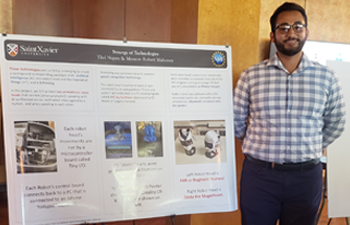
SXU Psychology Student Presents at Research Symposium

Saint Xavier University (SXU) psychology student Eliel Najera recently presented his project, "The Converging Synergy of Three Technologies," at SXU's 2023 EXPLORE STEM Research Fellowship Symposium.
Within his project, Najera, along with his mentor, Robert Mahoney, created and produced two talking robot heads to demonstrate the synergy of three converging technologies: artificial intelligence, microelectronics, and 3D printing. He also programmed the robot heads to respond to certain trigger words and have conversations.
"Technology is evolving, and I was interested in seeing how we're able to use it to our advantage. The robot heads had scripts programmed in the ARC software and responded to trigger words when interrogated by a human. Participating in projects like this one is truly beneficial because it helped me to develop new skills and learn how to work with different programs and software," said Najera.
Najera found that the most enjoyable aspect of the research symposium was seeing all the other projects students created. The symposium, along with his other courses, have set him up with skills that are highly sought after in the business world.
Najera was drawn to study psychology because he has always been interested in why people do the things they do and how certain aspects influence individuals. He chose SXU because of the small class sizes and the supportive faculty and staff.
"I truly feel like the faculty and staff at SXU want me to succeed. SXU has a plethora of resources and really prides itself on student success. I also truly enjoy the inclusivity at SXU," said Najera.
Najera will graduate in the spring and looks forward to beginning his professional career, hopefully in the marketing field.
This research program was supported by a grant from the National Science Foundation (No. 1832511).

